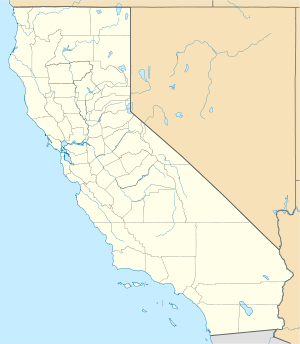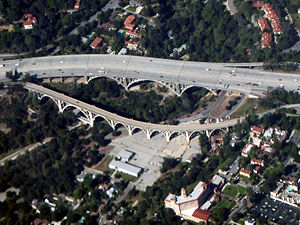Colorado Street Bridge (California)
Coordinates: 34 ° 8 ′ 40 " N , 118 ° 9 ′ 57" W.
| Colorado Street Bridge | ||
|---|---|---|
| use | Road bridge | |
| Crossing of | Arroyo Seco, S Arroyo Blvd | |
| place | Pasadena, California | |
| construction | Concrete arch bridge | |
| overall length | 447.30 m | |
| width | 12.70 m | |
| Number of openings | 9 | |
| Longest span | 46.18 m | |
| start of building | 1912 | |
| opening | 1913 | |
| planner | Waddell & Harrington | |
| location | ||
|
|
||
| The Colorado Street Bridge (below) and the Ventura Freeway with the Pioneers Bridge | ||
The Colorado Street Bridge is a road bridge over the Arroyo Seco in Pasadena , California , USA .
Opened in 1913, the concrete arch bridge was added to the list of historical milestones in civil engineering by the American Society of Civil Engineers in 1975, registered in the National Register of Historic Places in 1981 and is documented in the Historic American Engineering Record (HAER) .
location
The bridge lies in the course of West Colorado Boulevard (at that time Colorado Street ), the former most important connection between Pasadena and Glendale and Los Angeles . The Ventura Freeway with the 13-lane Pioneers Bridge , which has taken over the regional traffic, has been running north of it since 1953 . It spans the deeply cut valley of the Arroyo Seco , formerly a mostly dry stream bed in a sparsely populated area, but since the 1930s a fully concreted canal belonging to the Los Angeles County Flood Control District . Close to the canal is South Arroyo Boulevard , a winding, two-lane street. In the valley floor between the pillars of the large bridge stands the small Parker-Mayberry Bridge , built in 1914 to facilitate the cultivation of the adjacent plantations .
description
The Colorado Street Bridge crosses the Arroyo Seco in a long curve with a series of 9 concrete arches of different widths, which are flanked at both ends by 3 narrow round arches. The curve was necessary to avoid difficult underground conditions. Because of the different heights of the adjacent site, the bridge has an east-west gradient of 2.65%.
The reinforced concrete bridge is a total of 447.30 m (1467 ½ ft ) long, its greatest height above the ground is 45 m. The parabolic arches have spans (from west to east) of 46.18 + 67.97 + 46.18 + 34.75 + 5 × 34.44 m (in feet: 151 ½ + 223 + 151 ½ + 114 + 5 × 113 ft). The two-lane bridge originally had a 8.53 m wide carriageway and two 1.52 m wide sidewalks. During the restoration in the early 1990s, the bridge deck was extended by 30 cm on both sides and the roadway to 9.14 m (30 ft), but the sidewalks were somewhat narrowed so that the now prescribed guardrails could be installed between the roadway and the sidewalk. The balustrades are interrupted above each pair of pillars by a small balcony with a bench, which are flanked by two candelabra .
The arches each consist of two narrow parabolic arched ribs, which are flanked by slender pillars and are connected and stiffened by six flat cross beams. The individual arch sections are rectangular in plan; the long curve of the bridge is achieved by the fact that the closely spaced pillars on the outside are larger than on the inside.
The space between the pillars is divided into ten fields. This grid is decisive for the arrangement of the consoles under the carriageway slab, for the elevation of the carriageway slab on the arched ribs by means of narrow arches and a closed wall above the apex and for the arrangement of the crossbeams under the carriageway slab.
history
Since the late 1880s, a steep, narrow road led over a small bridge in the valley floor. At the beginning of the 20th century there was a desire for a modern, safe road connection. When the city had clarified the financing, it wrote out in July 1911 the draft of a viaduct to connect the two high banks. At the end of August, John Alexander Low Waddell , one of the partners of Waddell & Harrington from Kansas City , Missouri , received the planning contract . In November he presented the plan. In February 1912, Los Angeles County promised to pay half the cost. The construction was put out to tender, in March 1912 the construction work for the bridge was awarded to the company Mercereau Bridge and Construction Co. and in July 1912 construction began. In November 1913, a little later than planned, the bridge was completed and on December 13, 1913 it was ceremoniously opened.
In 1934 it became part of the state road system, but by 1935 the building was considered outdated and too small. In 1951 public protests prevented its demolition for the Ventura Freeway, instead the Pioneers Bridge was led past it in a wide arc. In the following years it was neglected. After the Loma Prieta earthquake , it was closed for security reasons in 1989 and renovated, made earthquake-proof and expanded for almost four years.
Web links
- Deborah Slaton: Colorado Street Bridge HAER CA-58 (PDF; 408 KB)
Individual evidence
- ↑ Memorial plaque on the bridge
- ↑ NRHP: 81000156
- ↑ Colorado Street Bridge HAER CAL, 19-PASA, 11-
- ↑ LACFD
- ↑ Deborah Slaton: Colorado Street Bridge , p. 10. At the beginning there is always talk of 11 arches, only in the technical description nine arches are properly mentioned.
- ↑ Deborah Slaton: Colorado Street Bridge , p. 23. For the length, the dimensions may vary slightly because the connections were redesigned when the Pioneers Bridge was built.
- ^ Mary Mallory: Pasadena's Colorado Street Bridge Celebrates 100th Anniversary. Article from June 17, 2013 in The Daily Mirror
- ↑ The Bridge Is Back: Landmarks: Pasadena celebrates the reopening of the 80-year-old Colorado Street span. After nearly four years of renovation, it is declared stronger than ever. Article of December 14, 1993 in the Los Angeles Times



